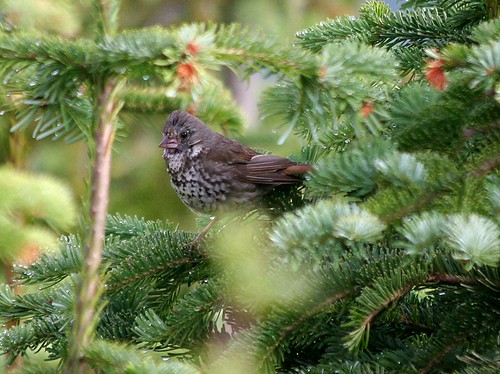tags: Fox Sparrow, Passerella iliaca, birds, mystery bird, bird ID quiz
[Mystery bird] Fox Sparrow, Passerella iliaca (sooty form), photographed in the Naches Pass Area, King County, Washington State. [I will identify this bird for you tomorrow]
Image: Marv Breece, 9 August 2007 [larger view].
Canon EOS 350D 1/400s f/5.6 at 300.0mm iso400.
Please name at least one field mark that supports your identification.
Rick Wright, Managing Director of WINGS Birding Tours Worldwide, writes:
Sometimes we take the coward's way out. Instead of rising to the challenge, we let a bird that is at first glance unfamiliar go as an lbb, a little brown bird. But if we give it a second glance, we'll find that every LBB is little in a different way, brown in a different way; and more often than not we come to an identification.
Depending on the geographic circumstances of our early birding experiences, this quiz bird can be unfamiliar indeed. If we look closely at it, though, the leaves it is perched among tell us that it really isn't so little after all; no one would mistake this bird, for example, for a Chipping Sparrow, a Cape May Warbler, or a Rufous Hummingbird, three (all quite dissimilar) brown birds that deserve to be called small. And a good close peer at the creature reveals precious little of what I'd call brown. The bird is white and gray and chestnut, but "brown" is the last color word I'd apply.
We can't see the bird's tail, so let's look at the bill. It's thick at the base, straight on the culmen, and sharp at the tip, recalling somewhat the chomper of a Pheucticus grosbeak. But the lack of a strong wing and head pattern, and the odd pattern of sharp streaks beneath rules out any species of that genus, and points us instead to the sparrows and buntings of the family Emberizidae.
Few sparrows have bills this intimidating. The largest among them, the towhees, are all distinctively plumaged; the streaked juveniles of the "rufous-sided" towhees are much messier, and all show white in the wing. Harris's Sparrow, next in size, shares this bird's rather plain face, but is otherwise entirely different in appearance, with a bright bill at all ages.
If we keep descending the scale of enormousness, we run into Fox Sparrow. Birders used to the Fox Sparrows of the north and east will have expected a brightly colored bird with fox-colored streaking above and below and rusty markings on the gray head, along with a bright yellow lower mandible. But the Fox Sparrow is one of the most strikingly variable taxa among North American sparrows, and the western subspecies groups are quite different from the birds of the east. Western birds tend to be more sparsely marked above, less rusty below, grayer-headed, and duller-billed than their eastern and northern cousins. This individual is a Fox Sparrow of the "Sooty" group, breeding along the Pacific coast from the eastern Aleutians to Washington.
As currently understood, the Fox Sparrow comprises about 17 subspecies, 7 of them in the Sooty group. In recent years more and more biologists have begun to treat the Fox Sparrow as three or four species, though the AOU still lists them as a single polytypic species. For a quick glimpse into the complexity of the issues involved, consider Beadle and Rising [Sparrows of the United States and Canada: The Photographic Guide], which split these birds into four species -- and then are forced to treat the northwestern interior altivagans as included within two of those species!


A lovely Fox Sparrow, similar to this one. Heavy bill, bold streaking on the breast, gray nape and rusty coloring on the wings and back. These "sooty" Fox Sparrows of the Pacific Northwest are quite different from the ones in the east or midwest!
I'm going to call that an adult Fox Sparrow of the "Slate-colored (interior West)" variety, per Sibley. The first thing that set me on that course was the beak; even though the streaking made me want to turn the bird into a thrush, there was no way to make the beak work.
I was thinking Fox Sparrow before I opened the field guide; I think I was recalling the gray head and back/rusty wings and tail combination from a Thick-billed race Fox Sparrow that I remember studying a few winters ago down here in SoCal. Looking at the Sibley illustrations, I note that color contrast on this bird, as well as the beak, the streaking, and the general lack of markings on the head and crown.
A sparrow.
Oh, great, another no-tail birdie pic. You people are kickin' my butt here. No response until further study. This one I am going to get right.
Oh, screw it. Fox Sparrow.
The arrow-shaped, or triangular breast spots that merge in the uppper breast make this a Fox Sparrow for me.
This bird's chip note is very distinctive. Even if you never see the bird, you know a Fox sparrow is lurking around. While I have great birds here in the central highlands of Mexico, I do miss the Fox sparrows of Seattle and Alaska.